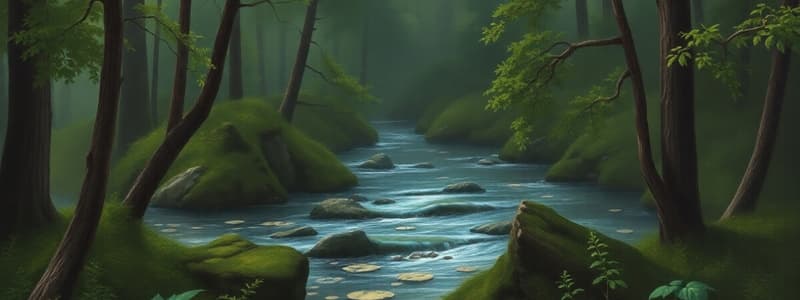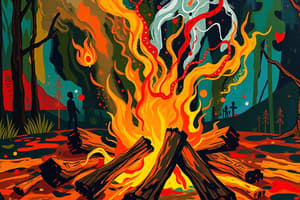Podcast
Questions and Answers
What did the narrator initially eat to try and find food?
What did the narrator initially eat to try and find food?
- A flower (correct)
- A twig
- A root
- A leaf
What was NOT a type of tree that the narrator found on Great-Grandfather's farm?
What was NOT a type of tree that the narrator found on Great-Grandfather's farm?
- Willow (correct)
- Maple
- Pine
- Beech
What did the narrator use to collect mussels from the stream?
What did the narrator use to collect mussels from the stream?
- A shovel
- A bucket
- A net
- Their hands (correct)
What did the narrator wrap the mussels in to cook them?
What did the narrator wrap the mussels in to cook them?
Why did the narrator laugh when seeing so many birds?
Why did the narrator laugh when seeing so many birds?
What did the narrator compare the taste of fresh-water mussels to?
What did the narrator compare the taste of fresh-water mussels to?
What did the narrator use to carry the collected mussels?
What did the narrator use to carry the collected mussels?
What did the narrator call the hickory trees on the farm?
What did the narrator call the hickory trees on the farm?
What did the narrator plan to make salt from?
What did the narrator plan to make salt from?
What did the stream on the land provide for the narrator?
What did the stream on the land provide for the narrator?
What did the narrator find at the site of the old Gribley home?
What did the narrator find at the site of the old Gribley home?
What did the narrator hope to find by poking around the foundations?
What did the narrator hope to find by poking around the foundations?
Why did the narrator decide to return with a shovel?
Why did the narrator decide to return with a shovel?
What types of starchy foods did the narrator find in the marsh?
What types of starchy foods did the narrator find in the marsh?
What kind of trees were in the forest that the narrator was drawn to?
What kind of trees were in the forest that the narrator was drawn to?
What was located at the center of the mountain meadow?
What was located at the center of the mountain meadow?
Flashcards
Hickory Salt
Hickory Salt
A method to extract salt by burning hickory branches.
Foundation Ruins
Foundation Ruins
Remnants of a building; often just stones and depressions in the ground.
Gribley Home Site
Gribley Home Site
A location where an old house used to be, now overgrown.
Nourishing Wild Apples
Nourishing Wild Apples
Signup and view all the flashcards
Shovel
Shovel
Signup and view all the flashcards
Marsh
Marsh
Signup and view all the flashcards
Cattails and Arrow-leaf
Cattails and Arrow-leaf
Signup and view all the flashcards
Mountain Meadow Boulder
Mountain Meadow Boulder
Signup and view all the flashcards
Warbler Migration
Warbler Migration
Signup and view all the flashcards
Edibility Test: Animal Observation
Edibility Test: Animal Observation
Signup and view all the flashcards
Freshwater Mussels
Freshwater Mussels
Signup and view all the flashcards
Steam with Coals
Steam with Coals
Signup and view all the flashcards
Hickory Tree
Hickory Tree
Signup and view all the flashcards
Hunger Pangs
Hunger Pangs
Signup and view all the flashcards
Mussels
Mussels
Signup and view all the flashcards
Hickory Nuts
Hickory Nuts
Signup and view all the flashcards
Study Notes
- Awaking the next morning, the narrator is surrounded by many birds and believes it to be the warbler migration.
- The birds are eating something from the maple trees, but the narrator cannot identify what it is.
- He recalls a book that suggests observing animal diets to identify edible plants.
- He remembers that raccoons have similar tastes to humans, but decides to go fishing instead.
- Unable to catch anything, a stream is thought to be an easy source of food.
- The narrator spots mussels.
- The narrator collects a peck of mussels from the icy water.
- He cooks the mussels in leaves over the fire, finding them delicious.
- The narrator explores Great-grandfather's farm, consisting mostly of maple and beech trees.
- There are also pine, dogwood, ash, and hickory trees present on the property.
- He sketches a map of the farm, marking the location of the hickory trees, as they will be a food source in the fall.
- The narrator finds the foundation of the old house ruins, stones outline the square shape, with trees growing in what was the living room area.
- He finds an old apple tree, finds a dried apple in the crotch of a tree, eaten but nourishing.
- The narrator also discovers three walnut trees.
- He hopes to find old iron implements but cannot because of the leaves and plants covering the area; he plans to return with a shovel.
- The narrator discovers a marsh with cattails and arrow-leaf, both sources of starch.
- He finds a mountain meadow with a large boulder in the center.
- The meadow is bordered by white birch, maples, and oaks.
- To the right is a hemlock forest with giant, old trees and moss-covered boulders.
- Standing before the biggest hemlock tree, the narrator has an idea.
Studying That Suits You
Use AI to generate personalized quizzes and flashcards to suit your learning preferences.
Description
The narrator wakes up surrounded by birds and tries to identify their food source. Recalling advice from a book, he considers observing animal diets to identify edible plants. He explores the farm, sketches a map, and locates hickory trees for future food.




